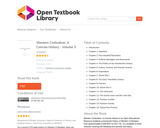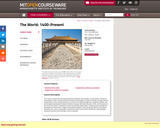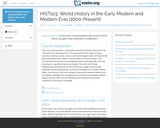
- Subject:
- U.S. History
- Material Type:
- Unit of Study
- Provider:
- Rice University
- Provider Set:
- OpenStax College


U.S. History is designed for a two-semester American history sequence. It is traditional in coverage, following a roughly chronological outline, and using a balanced approach that includes political, economic, social, and cultural developments. At the same time, the book includes a number of innovative and interactive features designed to enhance student learning. Instructors can also customize the book, adapting it to the approach that works best in their classroom.

Western Civilization: A Concise History is an Open Educational Resource textbook covering the history of Western Civilization from approximately 8,000 BCE to 2017 CE. It is available in three volumes covering the following time periods and topics:
Volume 3: from the Napoleonic era to the recent past. Volume 3 covers topics including the Industrial Revolution, the politics of Europe in the nineteenth century, modern European imperialism, the world wars, fascism, Nazism, and the Holocaust, the postwar era, the Cold War, and recent developments in economics and politics.
Table of Contents
Introduction
Chapter 1: Napoleon
Chapter 2: The Industrial Revolution
Chapter 3: Political Ideologies and Movements
Chapter 4: The Politics of the Nineteenth Century
Chapter 5: Culture, Science, and Pseudo-Science
Chapter 6: Imperialism
Chapter 7: World War I
Chapter 8: The Early Twentieth Century
Chapter 9: Fascism
Chapter 10: World War II
Chapter 11: The Holocaust
Chapter 12: The Soviet Union and the Cold War
Chapter 13: Postwar Conflict
Chapter 14: Postwar Society
Chapter 15: Toward the Present

This course surveys the increasing interaction between communities, as the barrier of distance succumbed to both curiosity and new transport technologies. It explores Western Europe and the United States' rise to world dominance, as well as the great divergence in material, political, and technological development between Western Europe and East Asia post–1750, and its impact on the rest of the world. It examines a series of evolving relationships, including human beings and their physical environment; religious and political systems; and sub-groups within communities, sorted by race, class, and gender. It introduces historical and other interpretive methodologies using both primary and secondary source materials.

This course will present a comparative overview of world history from the 17th century to the present era. The student will examine the origins of major economic, political, social, cultural, and technological trends of the past 400 years and explore the impact of these trends on world societies. Upon successful completion of this course, students will be able to: Think critically about world history in the early modern and modern eras; Assess how global trade networks shaped the economic development of Asia, Europe, and the Americas in the 17th and 18th centuries; Identify the origins of the Reformation and Counter-Reformation in Europe and assess the social and political consequences of these movements for the peoples of Europe; Identify the origins of the Enlightenment in Europe and assess how Enlightenment ideas led to political and social revolutions in Europe and the Americas; Identify the origins of the Scientific and Industrial Revolutions in Europe and assess how these intellectual and economic movements altered social, political, and economic life across the globe in the 18th and 19th centuries; Compare and contrast how European imperialism affected the states and peoples of Asia, Africa, and the Americas in the 19th century; Identify the origins of World War I and analyze how the war's outcome altered economic and political balances of power throughout the world; Identify the origins of totalitarian political movements across the globe in the 1920s and 1930s and assess how these movements led to World War II; Analyze how World War II reshaped power balances throughout the world and led to the emergence of the United States and the Soviet Union as global superpowers; Assess how decolonization movements in the 1950s and 1960s altered political, economic, and social relationships between the United States, the nations of Europe, and developing countries throughout the world; Assess how the end of the Cold War led to political and economic realignments throughout the world and encouraged the growth of new global markets and systems of trade and information exchange; Analyze and interpret primary source documents from the 17th century through the present, using historical research methods. (History 103)